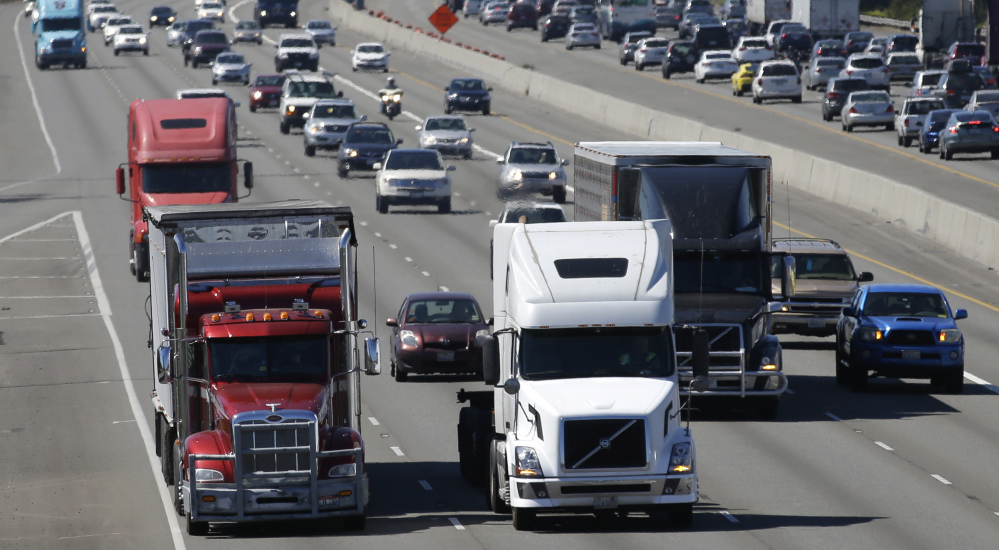DETROIT — Truckers are warning that a government plan to electronically limit the speed of tractor-trailers will lead to highway traffic jams and possibly an increase in deadly run-ins with cars.
More than 150 people, most identifying themselves as independent truckers, have filed comments recently with the government about the proposed rule, unveiled last month by two federal agencies. There were only a few comments in favor.
The government has proposed requiring electronic speed limiters on all trucks and buses over 26,000 pounds manufactured after the regulation goes into effect. Speeds could be limited to 60, 65 or 68 miles per hour when the rule is finalized after a comment period that ends Nov. 7.
Regulators and others favoring speed limiters say if trucks travel slower, the impact of a crash will be less severe and fewer people will be injured or killed. But truckers say the government is actually creating conditions for more collisions by focusing on the severity of the crash while ignoring the dynamic of trucks and cars traveling at different speeds.
Truckers also want to travel as far as they can in the hours they’re allowed to drive under federal rules.
The National Highway Traffic Safety Administration analyzed data from 2004 through 2013 and found that on average 1,044 people died per year in crashes involving heavy trucks on roads with speed limits of at least 55 mph.
The agency also found that if trucks speeds were limited to 60 mph, 162 to 498 lives per year would be saved because crashes would be less severe. At 65 mph, up to 214 lives would be saved, and as many as 96 would be saved with a 68 mph limit.
But truckers says slowing them down increases the chances of trucks being hit from behind by cars allowed to go 70 mph or more. Todd Spencer, executive vice president of the Owner-Operator Independent Drivers Association, the largest group of independent truckers, says most car-truck crashes on freeways where traffic is going the same direction involves a car rear-ending a truck.
“The net effect of their rule means that the truck will be running slower still,” Spencer said. “That’s a crash scenario that’s more severe.”
Doug Kruzan, a driver from Simpsonville, South Carolina, near Greenville, said he’s seen cars hit the back of slower trucks many times as the rigs move into the left lane to pass. “A car’s coming up behind him at 70, 75. They can’t slow down that quick,” said Kruzan.
NHTSA statistics show that of all the fatal crashes between big trucks and passenger vehicles in 2014, the latest year available, about 15 percent involved cars rear-ending large trucks. The Motor Carrier Safety Administration has reported that of 438,000 crashes involving large trucks in 2014, the front of the truck was the impact point in 38 percent of them. The rear of the truck was hit in 24 percent.
Many truckers say all vehicles should be limited to the same speed, but a NHTSA spokesman said that’s not being considered.
Truckers also say if the rule is adopted, tractor-trailers will try to pass each other at similar speeds, clogging traffic and frustrating car drivers. What’s more, they say, because the rule isn’t retroactive some truckers will try to prolong the lives of older trucks that otherwise would be replaced by newer models.
Steve Owings, an Atlanta financial planner, whose 2006 petition helped bring about the proposed regulation, says predictions of highway logjams are exaggerated.
Owings noted that a 2007 survey by the American Trucking Associations, the largest group of trucking companies in the nation, found that 69 percent of all trucking companies used speed limiters on at least some rigs. The average limit was 69 mph.
Owings believes the number of trucks with speed limiters has grown.
Send questions/comments to the editors.



Success. Please wait for the page to reload. If the page does not reload within 5 seconds, please refresh the page.
Enter your email and password to access comments.
Hi, to comment on stories you must . This profile is in addition to your subscription and website login.
Already have a commenting profile? .
Invalid username/password.
Please check your email to confirm and complete your registration.
Only subscribers are eligible to post comments. Please subscribe or login first for digital access. Here’s why.
Use the form below to reset your password. When you've submitted your account email, we will send an email with a reset code.